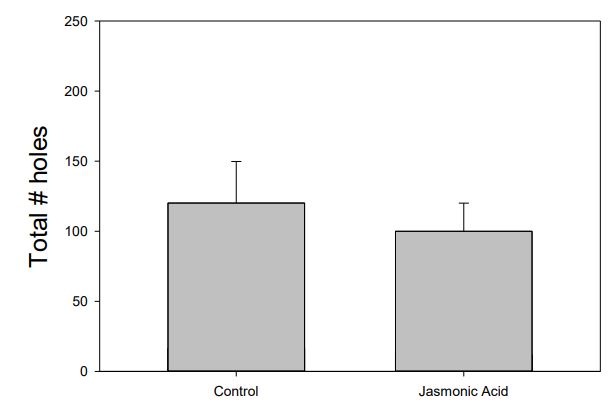Pilot Study on the effects of induced plant resistance to canola flea beetle in canola with the addition of jasmonic acid.
Principle Investigator: Dr. Gadi V.P. Reddy Cooperator: Dr. Brian Thompson
Western Triangle Agricultural Research Center, Montana State University, 9546 Old Shelby Rd.,
P.O. Box 656, Conrad, MT 59425, USA
Background:
Induction of plant resistance pathways may reduce insect damage by stimulating plant defense pathways prior to encounters with herbivores. Jasmonic acid is a plant hormone that induces plant defenses. In this pilot study, we looked at plant damage in induced and naïve plants exposed to canola flea beetle adults.
Methods:
-
Canola seeds were planted in plastic pots and grown to 3-4 leaf stage.
-
Seedlings on opposite sides of the pot (pairs) were treated with either a solution of 5 M jasmonic acid in 0.5% ethanol and water (JA) or treated with only 0.5% ethanol and water (Control).
-
A total of six potted plants (pairs) were placed in a mesh enclosure in a growth chamber with 50 adult canola flea beetles.
-
Beetles fed on plants over the course of one week (July 31st-August 6).
-
Leaves were removed at the end of the study, scanned into a pdf and percent leaf damage as a function of total leaf area was calculated using Adobe measurement tools.
-
Statistical analysis of paired samples was carried out using the software Sigma Plot V13.
Results:
-
Flea beetle damage to plants was calculated from damage on leaves (Figure 1).
-
Flea beetles damaged a higher proportion of leaves in the control treatment than in the jasmonic acid treated plants. (Figure 2)
-
The difference was not significant between damage levels (paired t-test, One-tailed P- value = 0.114).
-
Statistical power to reveal a difference between groups was low.
- The number of holes in the jasmonic acid treatment were fewer than for the control (Figure 3), but yet again statistical power was low and a statistically significant difference was not detected.
Discussion:
This simple experiment suggests jasmonic acid may be effective in reducing canola flea beetle damage in vulnerable canola seedlings. The amount of damage included total area of plant tissue removed and individual holes created in each leaf (Figure 3). These measures are correlated.
Increasing the sample size will improve our ability to differentiate the true effects of this type of treatment. We plan to increase the sample size in the coming year and repeat the experiment in the lab and also in the field.
Acknowledgements
Funding for this research was provided by U.S. Department of Agriculture-National Institute of Food and Agriculture (USDA-NIFA) Hatch (#MONB00859).
Figure 1: A) Jasmonic acid treated canola leaf and 2) the control untreated leaf collected from four leaf stage canola. Each exhibiting characteristic signs of canola flea beetle damage. The number of holes and their representative area were calculated as evidence of insect feeding damage.
Figure 2: Percent damage to plants stimulated with jasmonic acid and controls that did not receive jasmonic acid.
Figure 3: The number of individual holes in control and jasmonic acid treated plant leaves.



